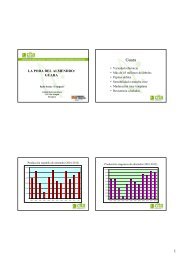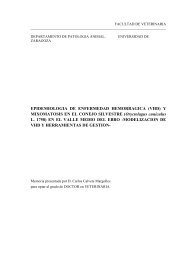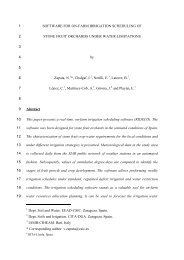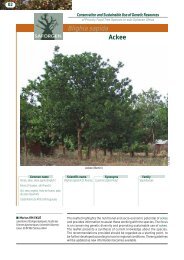1 A Recursive Dynamic Computable General Equilibrium Model For ...
1 A Recursive Dynamic Computable General Equilibrium Model For ...
1 A Recursive Dynamic Computable General Equilibrium Model For ...
You also want an ePaper? Increase the reach of your titles
YUMPU automatically turns print PDFs into web optimized ePapers that Google loves.
σ2<br />
σ1<br />
Figure A1: A Two-level nested production structure<br />
It is assumed that the underlying production function (A.1) is weakly separable<br />
implying (using Chambers’ (1988) notation):<br />
∂<br />
∂x<br />
3<br />
⎛ ∂X<br />
/ ∂x<br />
⎜<br />
⎝ ∂X<br />
/ ∂x<br />
1<br />
2<br />
⎞<br />
⎟ = 0<br />
⎠<br />
52<br />
(A.3)<br />
In words, this expression states that the ratio of marginal products (MRTS) of inputs<br />
x1 and x2, belonging to the same input nest X, is not affected by changes in the level of<br />
input usage of x3 which is not in that nest. The family of convenient functions such as CD<br />
and CES exhibit weak seperability, where in the case of a two-level nested CD production<br />
example:<br />
Y = AX X and X = Ax x<br />
(A.4)<br />
α<br />
1<br />
β<br />
2<br />
The MRTS 11,21 can be shown to be:<br />
MRTS<br />
11,<br />
21<br />
MP<br />
γ x<br />
1<br />
11 21<br />
= =<br />
(A.5)<br />
MP21<br />
δ x11<br />
Clearly, changes in the level of X2 in the upper CD nest, has no effect on the MRTS<br />
between inputs x11 and x21 in the lower nest. Mathematically:<br />
∂ ⎛ γ x<br />
⎜<br />
∂X<br />
2 ⎝ δ x<br />
21<br />
11<br />
⎞<br />
⎟ = 0<br />
⎠<br />
Y<br />
X x3<br />
x1 x2<br />
γ<br />
11<br />
δ<br />
21<br />
(A.6)
















